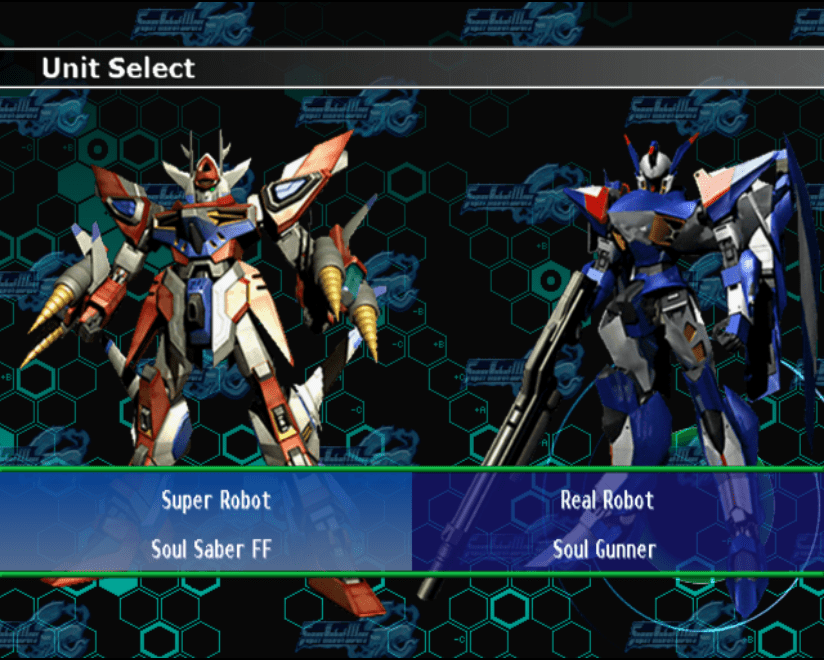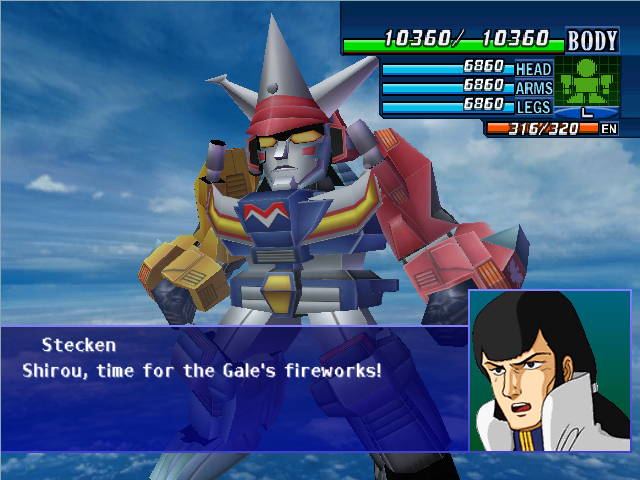Search
[{{{type}}}] {{{reason}}}
{{/data.error.root_cause}}{{{_source.title}}} {{#_source.showPrice}} {{{_source.displayPrice}}} {{/_source.showPrice}}
{{#_source.showLink}} {{/_source.showLink}} {{#_source.showDate}}{{{_source.displayDate}}}
{{/_source.showDate}}{{{_source.description}}}
{{#_source.additionalInfo}}{{#_source.additionalFields}} {{#title}} {{{label}}}: {{{title}}} {{/title}} {{/_source.additionalFields}}
{{/_source.additionalInfo}}- Details
- Category: GameCube
- By Daniel Cullen
- Hits: 2105
Super Robot Wars GC (GC)

Super Robot Wars GC
Developed By: AI
Published By: Banpresto (now Bandai Namco)
Released: December 16, 2004
Available On: GameCube, Xbox360
Genre: Turn-based Strategy
ESRB Rating: CERO A (would be ESRB T by western standards)
Number of Players: Singleplayer
Price: $32.59
Note: There is a "port" of this game for the Xbox 360 called XO, but due to numerous technical differences between the two, aside from some characters and most of the basic story, the two games are so different as to be almost entirely different titles in many respects, so all information below pertains to the Gamecube release. This was played via PC emulation, using a dumped Gamecube ISO from a legally purchased import disc and patched with a fan translation patch.
The Super Robot Wars series (which finally had an international release date announced game at the time of this writing) has occasionally mixed up their tried and true formula to experiment with different ideas. Some didn't pan out very well, but some turned out pretty good, with Super Robot Wars GC being one of their better ideas.
Super Robot Wars GC is one of the last games to heavily focus on the "classic" era of mecha anime, especially the 80's era, and its story is that Earth and the Sol solar system, in the wake of their attempts to colonize Mars being destroyed by a mysterious force, decides to militarize to prepare for the upcoming conflict. The space colonies of Earth break away to form a movement for independence that turns into a bitter war. As the Earth and space colonies wage war, the invasion that was feared begins, heralding a conflict that will span galaxies and dimensions to decide the fate of multiple worlds.
The following series are depicted, in whole or in part:

Strong Points: Added some unique concepts to the usual game engine SRW games use that worked quite well
Weak Points: One very severe but easily avoidable game-breaking bug
Moral Warnings: RPG style violence; frequent use of PG-13 level profanity like b**t**d, s***, and a**; an off-hand joke once of implied homosexuality; some mentions of pagan religious worship and implications of necromancy; depictions of bigotry and racism (albeit in an entirely negative light)
Super Robot Wars GC is a top-down turn-based strategy RPG. It has an intermission during which units can be upgraded and pilots switched out between different machines. The story is told in visual novel-style sequences before and after each stage, establishing the story of this crossover conflict piece by piece. Like all SRW titles, it provides a lot of room for "meta-gaming", or customizing your teams of robots and pilots to work best for beating levels and to play to your gaming strengths.
This game also featured a few unique things that have been uncommon in SRW games, with two innovations GC pioneered. The first is "unit parts", or smaller units being able to cripple the head, legs, and arms of an enemy unit to capture it without destroying it and weaken its accuracy, power, and mobility. Second is the idea of repeatable stages, specifically substages that need not be played, but will show additional story scenes, unlock certain secrets, and otherwise allow players to "farm" for extra money, capturable enemy units, and spare parts for robot enhancement.
Graphically, they did something new, which was fully animated 3D models for the Gamecube battle scenes. Super Robot Wars 64 had a form of pseudo-3D, which involved sprites and clever camera tricks to give an illusion of 3D, but GC is when they made fully animated models, not sprites. They look fine, though the animation is somewhat stiff at times, though excellent for the time it was made. The rest of the game uses sprites and hand-drawn animation, all rendered using a fairly faithful "eighties" style, which complements the included series well, makes them all not clash too horribly, and looks fairly good when scaled up on high resolutions.
Sounds and music use the classic anime-style instrumentals of the series included and appropriate sounds from the series in question. The voiceovers are in Japanese and sound fairly crisp for their era as well. Controls were intended for a Gamecube controller and easily map to any standard PC gamepad or even the keyboard if you play via emulation.
There is only one notable but serious stability issue: A save file destroying bug that has existed since the original release. If the unit capture feature is used to capture a Gaza-C mobile suit unit in either mobile suit or mobile armor modes, it can permanently corrupt save files or at the very least cause severe glitches that cause the player to skip certain levels and miss several secret units. I recommend this glitch be avoided by simply shooting these down in all cases whatsoever. Aside from that, this game runs fine in emulation and on real hardware; the only other glitches are emulation imperfections (which is more the fault of the emulator if played via emulation), though I noticed none of note.
Morally, this game, given it was translated to English with many things rendered as literally as possible, has some potential red flags and some things that need a bit of elaboration.
Violence is of the typical "give orders and watching it happen" RPG variety, rendered as sterile and bloodless as possible, with bodies disappearing immediately with no remains. It's worth noting your protagonists (referred to as the "White Base Corps" after their primary carrier) make a special point to attempt to negotiate and request enemy forces surrender whenever possible, with violence only taking place via lawful military orders and under the rationale of self-defense.
Language tends to stay mostly in the mild PG-13 category, with h*ll, d**m, and b**t**d being fairly common, with some very rare mentions of s*** and b***h. Sexual dialogue stays fairly clean; the closest it gets to anything resembling inappropriate is a once-off joke implying two guys are more than friends (which is a good-natured joke and nothing more).
Sexual content is almost nil, with hardly any mention or depiction of anything inappropriate. The occult and supernatural are also rare sights, with two exceptions. One villain is a clear devotee of Atum, the Egyptian god of creation and rebirth, but they are considered evil, and their conduct reflects this. Another villain uses a form of necromancy (its exact nature is left unclear, with hints at both actual magic and technology being equally likely for how it works) to bring their henchman back from death, but this is not explored in much detail and left otherwise ambiguous. All other things depicted are revealed to be based in science-fiction or otherwise have a rational cause.

Higher is better
(10/10 is perfect)
Game Score - 82%
Gameplay - 17/20
Graphics - 8/10
Sound - 8/10
Stability - 3/5
Controls - 5/5
Morality Score - 67%
Violence - 6/10
Language - 4/10
Sexual Content - 10/10
Occult/Supernatural - 6/10
Cultural/Moral/Ethical - 7.5/10 (+6 for decrying the evils and foolishness of bigotry and racism and emphasizing the role fathers have to impart moral guidance to their children.)
There is at least one positive reference to God, in which one character openly prays to God to have the life of a friend spared, which will happen only by the player making it possible, and the game encourages you to do so. One character has the last name of "God" (this being a literal last name), but this is not intended as purposeful sacrilege. Finally, consistent with how many Japanese mecha anime use the terms "God" and "Devil" and similar terms to denote moral alignment, many good guys have machines whose names have some form of "God" in the name, while the villains have "Devil", "Jaku" (meaning "evil" in Japanese), or other similar terms to show they are on the villain team. The series Mazinkaiser has the "you can be a god or devil" theme from its parent Mazinger franchise, which means one can choose between acting like God or acting as the Devil, with an obvious preference for the former.
None of this is meant to do more than show who is the hero and who is the villain. Finally, a few villains do claim to be blessed or otherwise acting with the sanction of God, though in all cases this is generally just a rationalization of themselves as being right for doing what is wrong.
In terms of ethics, this is a story where a lot of wars and their consequences are depicted. Your heroes make a point to conduct themselves as honorable third parties, and while they are, on paper, loyal to the Earth Federation faction, they make honest efforts to broker peace between all factions and support all legitimate governing bodies with anything resembling morals. It's revealed one of the legitimate bodies of government they intended to restore after a coup d'etat had a dark nature that was unknown to most of the survivors, but the surviving prince of said power (who serves as one of the heroes and was unaware of these revelations prior) fully intends to own the dark past of his kingdom and allow reforms to prevent a repeat of that shameful history.
There are some themes of prejudice depicted, mainly by humans and aliens who believe they are considered superior to other beings, though none of this is depicted positively, and some unfavorable references are even made to Hitler in terms of the unfairness at one point. Other themes in support of decrying bigotry are also prevalent, such as pointing out no one of any social standing has an inherent right to be bigoted or demean the dignity of anyone else because of that social standing.
There is another positive redeeming moral theme, depicted by fathers on both sides of the conflict, of trying to impart wisdom on their children. Those who obey and accept this advice are shown to grow as people, while those who spurn their fathers or father figures' wisdom are shown to pay for their folly.
In technical terms, this is a Super Robot Wars game that dared to innovate and did it well, that game-breaking bug being its only serious demerit. Morally, it does have issues with frequent profanity and some occult themes as well as some racism depictions. However, this contrasted nicely with themes showing the folly and evil of racism as well as a moral about the wisdom of fathers and how that wisdom is meant to bring moral improvement to their children. Overall, it's a fine game worth playing and worth getting if you can legally acquire it and apply the English patch to play if you cannot read Japanese.






